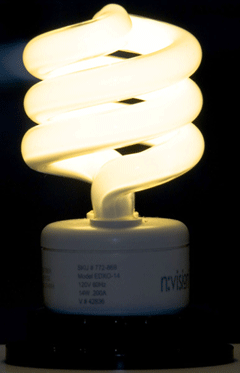Broken Bulb Dreams
Air Date: Week of March 14, 2008

Mercury is a key ingredient in fluorescent light bulbs and has negative environmental and health effects. (Photo: Environmental Protection Agency)
Trading in your incandescent bulbs for compact fluorescent bulbs may be an easy fix for folks who want to cut their carbon footprint. But as Consumer’s Union senior scientist Urvashi Rangan tells host Steve Curwood, compact fluorescents contain mercury, which may be harmful to your health if the bulb breaks or is thrown in the trash.
Transcript
CURWOOD: Now, one of the easiest carbon-cutting ideas is to swap out incandescent light bulbs and replace them with compact fluorescent bulbs. Compact fluorescents have been touted as the Great Light Hope, but there are problems with these bulbs: they contain a small amount of toxic mercury. A broken bulb can emit vapors that may be dangerous to a person’s health, and disposal is a problem. With me now to shine, well, a light on this subject is Urvashi Rangan. She’s a senior scientist and policy analyst with Consumer’s Union. Dr. Rangan, welcome back to Living on Earth.
RANGAN: Thank you so much, Steve.
CURWOOD: Dr. Rangan, there are a couple of studies, I think one done by the state of Maine and another from the Mercury Policy Project based in Vermont, that have issued some reports on the risks of mercury poisoning to infants, children, and pregnant women if compact fluorescent bulbs break. What are the findings of those reports?
RANGAN: In those reports they reported on a series of experiments that they did where they broke compact fluorescent bulbs in a small or moderate sized room, and then they conducted various clean-up techniques. And then they tested the air at various height levels that would represent either an infant walking around, or a toddler, or an adult. So they looked at one foot and five feet in terms of the height differential and the amount of mercury that was found at those different height levels.
CURWOOD: And if you’re at the lower level, you’re in a lot more trouble I gather.
RANGAN: It definitely seemed to be the case that at the one foot level, you had a lot more mercury cloud aerosolized, and so that’s why the danger to infants and toddlers was flagged in this case.
CURWOOD: So wait a second – I have a compact fluorescent bulb, I drop it, I break it on the carpet in my living room, and suddenly I have a major health hazard?
RANGAN: You actually have a small hazard going on. And the trick to cleaning this is actually to get rid of the spot where the compact fluorescent bulb landed – that is, if it’s rug – and the best advice for getting rid of it is to cut that piece of rug out, or if it’s an area rug, to get it out of the room. That’s the most surefire way of making sure that you get the mercury out of your room.
CURWOOD: Now, details on the clean-up procedures will be on our website. But what are consumers supposed to do here, Urvashi?

Urvashi Rangan is senior scientist and policy analyst with Consumers Union. She warns green-minded consumers to be aware of risks that come with fluorescent light bulbs. (Photo: Consumers Union)
CURWOOD: So what am I supposed to do when my compact fluorescent light bulb quits working, you know flickers one last time?
RANGAN: Well in some states they actually require you to recycle them, and there’s a variety of different options. Sometimes there’s a curbside pick-up, where things like your lithium batteries, old cans of paint, other household hazardous waste would go, and that’s where your compact fluorescents would go as well. Alternatively, some states may have drop-off locations, or they may have collection days a couple days a year.
CURWOOD: What about retailers, the people that sold me these bulbs? What about having them take them back?
RANGAN: There are some retailers like IKEA that have stepped up to the plate and offer a take-back center for these bulbs, and that’s really I think noble on behalf of the retailers to be offering these things. But convenience is often a factor in how effective recycling can be, and if it’s not convenient, products are often not recycled.
CURWOOD: Now, why do compact fluorescent bulbs have mercury in them in the first place?
RANGAN: It’s actually part of the technology to light those bulbs. You need mercury vapor. And so one has to really ask, while there’s been a lot of hype and focus on the energy efficiency of compact fluorescents and fluorescent lighting in general, is it really the overall sustainable solution? Compact fluorescents are more energy efficient, I mean no one can argue with that, but there are other technologies, like LED technology, that are really offering even less toxic, as energy efficient alternatives. And I think that compact fluorescents may just be a stop along the way in terms of finding the most sustainable solution.
And we also have to look at how these things need to be disposed, how are they produced, how much energy goes into all of that, and how much energy goes into recycling these things once they’re done. So all of those things also need to be taken into account when we’re looking at overall sustainability.
CURWOOD: Urvashi Rangan is a senior scientist and policy analyst with Consumer’s Union. Thanks for taking the time, Urvashi.
RANGAN: Steve, thanks so much.
Links
To read the report “Shedding Light on Mercury Risks from CFL Breakage,” click here
Living on Earth wants to hear from you!
Living on Earth
62 Calef Highway, Suite 212
Lee, NH 03861
Telephone: 617-287-4121
E-mail: comments@loe.org
Newsletter [Click here]
Donate to Living on Earth!
Living on Earth is an independent media program and relies entirely on contributions from listeners and institutions supporting public service. Please donate now to preserve an independent environmental voice.
NewsletterLiving on Earth offers a weekly delivery of the show's rundown to your mailbox. Sign up for our newsletter today!
 Sailors For The Sea: Be the change you want to sea.
Sailors For The Sea: Be the change you want to sea.
 The Grantham Foundation for the Protection of the Environment: Committed to protecting and improving the health of the global environment.
The Grantham Foundation for the Protection of the Environment: Committed to protecting and improving the health of the global environment.
 Contribute to Living on Earth and receive, as our gift to you, an archival print of one of Mark Seth Lender's extraordinary wildlife photographs. Follow the link to see Mark's current collection of photographs.
Contribute to Living on Earth and receive, as our gift to you, an archival print of one of Mark Seth Lender's extraordinary wildlife photographs. Follow the link to see Mark's current collection of photographs.
 Buy a signed copy of Mark Seth Lender's book Smeagull the Seagull & support Living on Earth
Buy a signed copy of Mark Seth Lender's book Smeagull the Seagull & support Living on Earth

